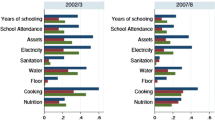Abstract
Despite nearly three decades of revolutionary government rule, poverty and inequality remain the central issues of political debate in Iran. The unexpected electoral victory of Ahmadinejad, the populist candidate in the 2005 presidential election, has been widely attributed to rising poverty and inequity. Using household survey data, I examine the trends in poverty and inequality for the last three decades and show that this thesis is not grounded in facts. Survey data show that poverty has substantially declined in recent years, and is low by international standards and in comparison with pre-revolution years. This finding is consistent with pro-poor policies of the Islamic government, mainly in provision of basic infrastructure such as electricity, safe drinking water, and health. However, the same policies have not been as effective in reducing inequality, which, after an initial decline following the Revolution, has remained basically constant in the post-Revolution period.
Similar content being viewed by others
References
Abbasi-Shavazi, M.J., Mehryar, A.H., Jones, G., McDonald, P.: Revolution, war and modernization: population policy and fertility change in Iran. J. Popul. Res. 19(1), 25–46 (2002)
Amuzegar, J.: Iran’s Economy under the Islamic Republic. I. B. Tauris, London (1993)
Amuzegar, J.: Iran’s third development plan: an appraisal. Middle East Policy 12(3), 46–64 (2005)
Anand, S., Kanbur, S.M.R.: The Kuznets process and the inequality–development relationship. J. Dev. Econ. 40(1), 25–52 (1993)
Assadzadeh, A., Paul, S.: Poverty, growth, and redistribution: a study of Iran. Rev. Dev. Econ. 8(4), 640–53 (2004)
Bayat, A.: Workers and Revolution in Iran. Zed Books, London (1987)
Behdad, S.: Winners and losers of the Iranian revolution: a study in income distribution. Int. J. Middle East Stud. 21(3), 327–358 (1989)
Behdad, S.: From populism to economic liberalism: the Iranian predicament. In: Alizadeh, P. (ed.) The Economy of Iran: Dilemmas of an Islamic State, pp. 100–141. I. B. Tauris Publishers, New York (2000)
Biewen, M.: Bootstrap inference for inequality, mobility and poverty measurement. J. Econom. 108, 317–342 (2002)
Biewen, M., Jenkins, S.: Estimation of generalized entropy and Atkinson indices from complex survey data. Oxf. Bull. Econ. Stat. 68(3), 371–383 (2006)
Central Intelligence Agency: World Factbook. United States Government, Washington, DC (2005)
Deininger, K., Squire, L.: A new data set measuring income inequality. World Bank Econ. Rev. 10(3), 565–591 (1996)
Dollar, D., Kraay, A.: Growth is good for the poor. J. Econ. Growth 7(3), 195–225 (2002)
Duclos, J.-Y., Esteban, J., Ray, D.: Polarization: concepts, measurement, estimation. Econometrica 72(6), 1737–1772 (2004)
Esfahani, H.S.: Alternative public service delivery mechanisms in Iran. Q. Rev. Econ. Finance 45(2–3), 497–525 (2005)
Fields, G.S.: Distribution and Development. Russell Sage Foundation, New York (2001)
Ghamari, B.: What’s the matter with Iran? Counterpunch (July 5) (2005)
Hoodfar, H., Assadpour, S.: The politics of population policy in the Islamic Republic of Iran. Stud. Fam. Plann. 31(1), 19–34 (2000)
Jolliffe, D., Semykina, A.: Robust standard errors for the Foster-Greer-Thorbecke class of poverty indices: SEPOV. Stata Tech. Bull. 51, 34–36 (1999)
Kuznets, S: Economic growth and inocme inequality. Am. Econ. Rev. 45(1), 1–28 (1955)
Lanjouw, J.O.: Demystifying poverty lines. Discussion Paper, UNDP, New York (2000)
Management and Planning Organization: Barnameh mobarezeh ba faghr (program for fighting poverty). Technical report, Management and Planning Organization, Tehran, Iran. Report (in Persian) (2000)
Milanovic, B.: Determinants of cross-country income inequality: an augmented Kuznets hypothesis. Policy Research Working Paper Series 1246, The World Bank. Available at http://ideas.repec.org/p/wbk/wbrwps/1246.html. (1994)
Molavi, A.: Buying time in Tehran. Foreign Aff. 83(6) (2004)
Nomani, F., Behdad, S.: Class and Labor in Iran: Did the Revolution Matter? Syracuse University Press, Syracuse, New York (2006)
Nowshirvani, V., Clawson, P.: The state and social equity in post-revolutionary Iran. In: Weiner, M., Banuazizi, A. (eds.) The Politics of Social Transformation in Afghanistan, Iran, and Pakistan. Syracuse University Press, Syracuse, New York. (1994)
Pajouyan, J.: Establishing the poverty line. In: Iran Economic Review, vol. 1(1). Tehran Univerity (1994)
Pesaran, M.H.: Income distribution and its major determinants in Iran. In: Jacqz, J.A. (ed.) Iran: Past, Present and Future, pp. 267–286. Aspen Institute for Humanistic Studies, New York (1976)
Pesaran, M.H.: Economic trends and macroeconomic policies in post-revolutionay Iran. In: Alizadeh, P. (ed.) The Economy of Iran: The Dilemmas of an Islamic State, pp. 63–100. I.B. Tauris, London (2000)
Raisdana, F., Shadi-Talab, J., Piran, P. (eds.): Faghr dar Iran (Poverty in Iran). Social Welfare University, Tehran, Iran (2000)
Saeidi, A.A.: Charismatic political authority and populist economics in postrevolutionary Iran. Third World Q. 22(2), 219–236 (2001)
Salehi-Isfahani, D.: Poverty Measurement in Iran. Working Paper, Virginia Tech Department of Economics, mimeo (2003)
Salehi-Isfahani, D.: Human resources in Iran: potentials and challenges. Iran. Stud. 38(1), 117–147 (2005)
Salehi-Isfahani, D.: Revolution and Redistribution in Iran: Inequality and Poverty 25 Years Later. Working Paper, Department of Economics, Virginia Tech (2006)
Sazgara, M.: The point of no return, Iran’s path to democracy. Policy Focus, number 54. Washington Insitute for Near East Policy, Washington, DC (2006)
Shorrocks, A.F.: The impact of income components on the distribution of family incomes. Q. J. Econ. 98(2), 311–26 (1983)
Summers, R., Heston, A., Aten, B.: Penn world table (mark 6.1). Computer file (2002)
Tabibian, M.: Faghr va touzie daramad dar Iran (Poverty and Income Distribution in Iran). Institute for Research in Planning and Development, Tehran, Iran (2000)
United Nations: United Nations common country assessment for the Islamic Republic of Iran. Technical report, United Nations, New York (2003)
World Bank: World Development Indicators, 2005. Available on CDROM from the World Bank, Washington DC (2005)
Yaghmaian, B.: Social Change in Iran: An Eyewitness Account of Dissent, Defiance, and New Movements for Rights. State University of New York Press, Albany, NY (2002)
Author information
Authors and Affiliations
Corresponding author
Rights and permissions
About this article
Cite this article
Salehi-Isfahani, D. Poverty, inequality, and populist politics in Iran. J Econ Inequal 7, 5–28 (2009). https://doi.org/10.1007/s10888-007-9071-y
Received:
Accepted:
Published:
Issue Date:
DOI: https://doi.org/10.1007/s10888-007-9071-y




